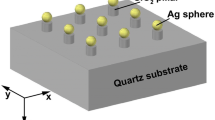Abstract
A plasmonic coupling structure composed of Ag nanocap–nanohole pairs was fabricated through a novel and facile method. Both surface-enhanced Raman scattering (SERS) measurements and numerical simulations show that the cap-hole system produces much larger electric field enhancement and SERS signal than the isolated structures, which is due to the plasmonic coupling effect between the gap of the cap and the hole. Additionally, the plasmonic enhancement is sensitive to the gap size, which can be controlled by the Ag layer thickness during the evaporation process. A maximum enhancement factor of 1.1×108 can be obtained with optimized gap size.



Similar content being viewed by others
References
Nie S, Emory SR (1997) Probing single molecules and single nanoparticles by surface-enhanced Raman scattering. Science 275(5303):1102–1106
Winkler K, Kaminska A, Wojciechowski T, Holyst R, Fialkowski M (2011) Gold micro-flowers: one-step fabrication of efficient, highly reproducible surface-enhanced Raman spectroscopy platform. Plasmonics 6(4):697–704
Yi M, Zhang D, Wang P, Jiao X, Blair S, Wen X, Fu Q, Lu Y, Ming H (2011) Plasmonic interaction between silver nano-cubes and a silver ground plane studied by surface-enhanced Raman scattering. Plasmonics 6(3):515–519
Michaels AM, Nirmal M, Brus LE (1999) Surface enhanced Raman spectroscopy of individual rhodamine 6g molecules on large ag nanocrystals. J Am Chem Soc 121(43):9932–9939
Otto A, Mrozek I, Grabhorn H, Akemann W (1992) Surface-enhanced Raman scattering. J Phys Condens Matter 4:1143–1212
Moskovits M (1985) Surface-enhanced spectroscopy. Rev Mod Phys 57(3):783–826
Metiu H, Das P (1984) The electromagnetic theory of surface enhanced spectroscopy. Annu Rev Phys Chem 35(1):507–536
Ye J, Shioi M, Lodewijks K, Lagae L, Kawamura T, Van Dorpe P (2010) Tuning plasmonic interaction between gold nanorings and a gold film for surface enhanced Raman scattering. Appl Phys Lett 97(16):1–3
Im H, Bantz KC, Lindquist NC, Haynes CL, Oh SH (2010) Vertically oriented sub-10-nm plasmonic nanogap arrays. Nano Lett 10(6):2231–2236
Wei H, Håkanson U, Yang Z, Höök F, Xu H (2008) Individual nanometer hole-particle pairs for surface-enhanced Raman scattering. Small 4(9):1296–1300
Wen X, Yi M, Zhang D, Wang P, Lu Y, Ming H (2011) Tunable plasmonic coupling between silver nano-cubes and silver nano-hole arrays. Nanotechnology 22:85203–85209
Lu Y, Liu GL, Kim J, Mejia YX, Lee LP (2005) Nanophotonic crescent moon structures with sharp edge for ultrasensitive biomolecular detection by local electromagnetic field enhancement effect. Nano Lett 5(1):119–124
Kneipp K, Kneipp H, Kartha VB, Manoharan R, Deinum G, Itzkan I, Dasari RR, Feld MS (1998) Detection and identification of a single DNA base molecule using surface-enhanced Raman scattering (SERS). Phys Rev E 57(6):6281–6284
Love JC, Gates BD, Wolfe DB, Paul KE, Whitesides GM (2002) Fabrication and wetting properties of metallic half-shells with submicron diameters. Nano Lett 2(8):891–894
Zhang Y, Barhoumi A, Lassiter JB, Halas NJ (2011) Orientation-preserving transfer and directional light scattering from individual light-bending nanoparticles. Nano Lett 11(4):1838–1844
Wei H, Hao F, Huang Y, Wang W, Nordlander P, Xu H (2008) Polarization dependence of surface-enhanced Raman scattering in gold nanoparticle-nanowire systems. Nano Lett 8(8):2497–2502
Mirin NA, Halas NJ (2009) Light-bending nanoparticles. Nano Lett 9(3):1255–1259
Palik ED (1998) Handbook of optical constants of solids III. Academic, New York
Moskovits M (2006) Surface-enhanced Raman spectroscopy: a brief perspective. In: Kneipp K, Moskovits M, Kneipp H (eds) Surface-enhanced Raman scattering: physics and applications. Topics in applied physics, vol 103. Springer, New York, pp 1–17
Wu H-Y, Cunningham BT (2011) Plasmonic coupling of sio[sub 2]-ag“post-cap” nanostructures and silver film for surface enhanced Raman scattering. Appl Phys Lett 98(15):153103–153105
Yamaguchi K, Inoue T, Fujii M, Haraguchi M, Okamoto T, Fukui M, Seki SHU, Tagawa S (2007) Electric field enhancement of nano gap of silver prisms. Chin Phys Lett 24(10):2934–2937
Lévêque G, Martin OJF (2006) Optical interactions in a plasmonic particle coupled to a metallic film. Opt Express 14(21):9971–9981
Zhu W, Banaee MG, Wang D, Chu Y, Crozier KB (2011) Lithographically fabricated optical antennas with gaps well below 10 nm. Small 7(13):1761–1766
Van Duyne RP, Hulteen JC, Treichel DA (1993) Atomic force microscopy and surface-enhanced Raman spectroscopy. I. Ag island films and Ag film over polymer nanosphere surfaces supported on glass. J Chem Phys 99(3):2101–2115
lIN WC, Huang SH, Chen CL, Chen CC, Tsai DP, Chiang HP (2010) Controlling sers intensity by tuning the size and height of a silver nanoparticle array. Appl Phys A Mater Sci Process 101:185–189
Acknowledgements
This work is supported by the National Basic Research Program (973 Program) of China under grant no. 2012CB921900, the Key Program of National Natural Science Foundation of China, no. 61036005, and National Natural Science Foundation of China, nos. 11074241, 11004182. Xiaojin Jiao and Steve Blair acknowledge support from the University of Utah MRSEC, NSF grant no. DMR 1121252.
Author information
Authors and Affiliations
Corresponding author
Rights and permissions
About this article
Cite this article
Wen, X., Xi, Z., Jiao, X. et al. Plasmonic Coupling Effect in Ag Nanocap–Nanohole Pairs for Surface-Enhanced Raman Scattering. Plasmonics 8, 225–231 (2013). https://doi.org/10.1007/s11468-012-9379-8
Received:
Accepted:
Published:
Issue Date:
DOI: https://doi.org/10.1007/s11468-012-9379-8




